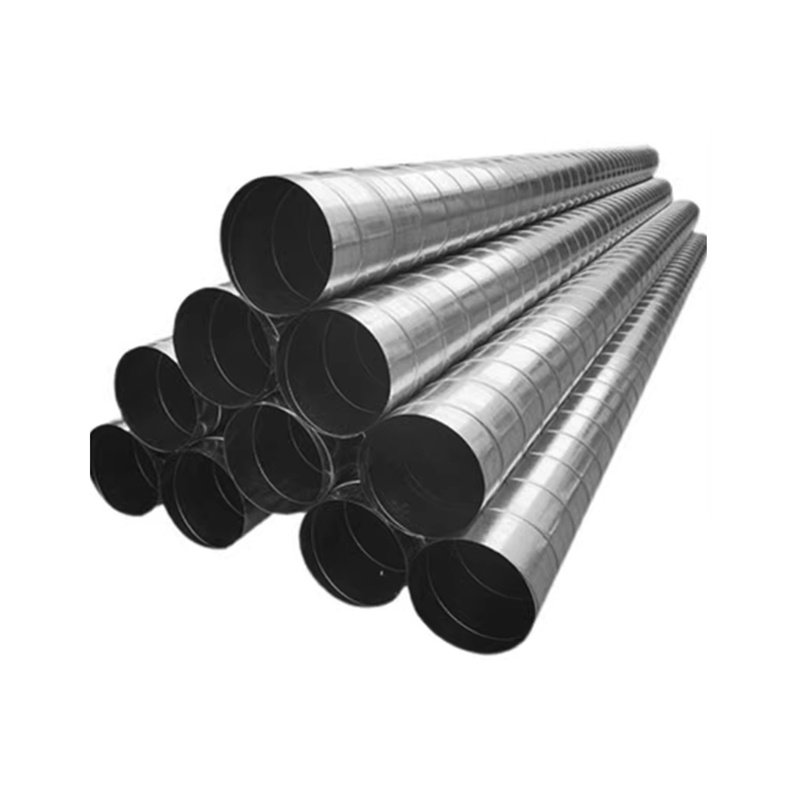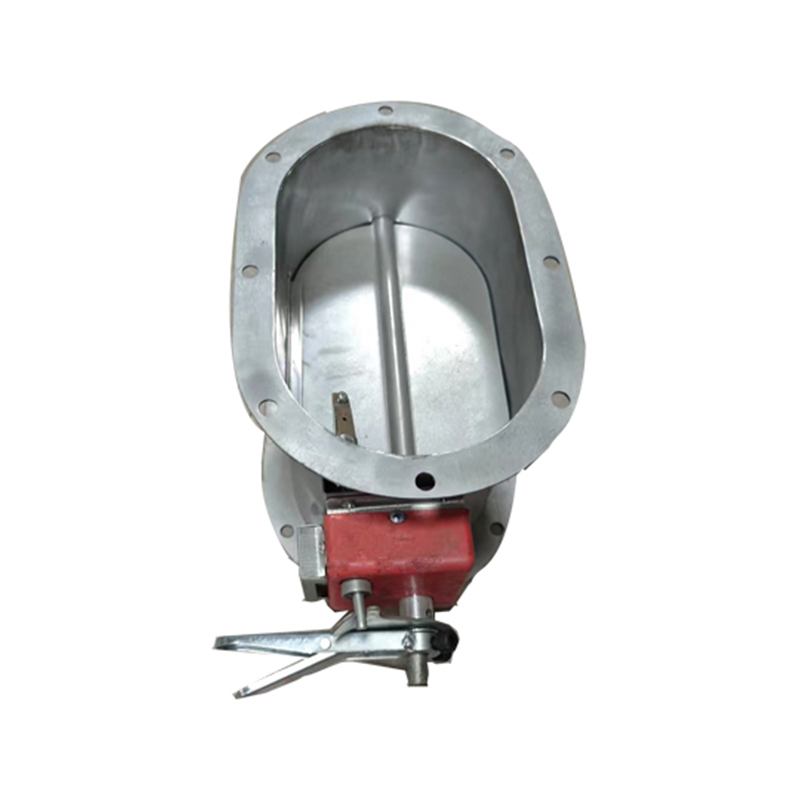How does the material selection of oval duct affect the durability and performance of the overall system?
Release Time : 2025-07-01
As an important component of the ventilation system of modern buildings, the material selection of oval duct directly affects the durability and performance of the entire system. The right material can not only enhance the structural strength and corrosion resistance of the duct, but also improve the airflow transmission efficiency and ensure the stable operation of the system under various environmental conditions.
First of all, the choice of material determines the basic physical properties of oval duct. Metal is one of the most commonly used materials for manufacturing such ducts because of their excellent mechanical strength and durability. For example, materials such as galvanized steel, stainless steel and aluminum alloy are widely used in the production of ventilation ducts. These metal materials have high rigidity and can maintain their shape when subjected to external pressure and internal airflow impact. Especially for those ducts that need to pass through multi-story buildings or are exposed to harsh external environments, a strong structure is essential. Strong materials can effectively withstand wind pressure, snow loads and possible accidental impacts, ensuring the long-term stability of the ventilation system.
Secondly, there are significant differences in the resistance of different materials to corrosion. Galvanized steel prevents steel from direct contact with air by covering its surface with a layer of zinc, thereby delaying the oxidation process. This treatment allows galvanized steel ducts to be used for a long time in a humid environment without rusting. In contrast, stainless steel, due to its alloy composition, has stronger resistance to oxidation and corrosion, and is suitable for more severe working conditions, such as chemical plants or coastal areas in high-salt, high-humidity environments. Although aluminum alloys have relatively low hardness, they are light and not easy to corrode, making them particularly suitable for weight-sensitive or frequently transported and installed occasions.
In addition to basic physical and chemical properties, the material also affects the thermal conductivity of the duct. Good thermal conductive materials can help regulate indoor temperature and reduce energy consumption. For example, certain high-performance alloy materials can effectively isolate heat transfer, making the ventilation system perform better in terms of winter insulation and summer insulation. In addition, for some specific applications, such as hospitals or laboratories, the duct is required to have certain fireproof properties. At this time, it is particularly important to select special alloys that meet fireproof standards or materials with fireproof coatings. These materials can not only prevent the spread of flames when a fire occurs, but also buy valuable time for personnel evacuation.
Furthermore, the choice of material is also related to the processing technology of the duct and the quality of its final product. High-quality raw materials facilitate precise cutting, bending and welding operations, ensuring that every seam is tight and seamless to avoid air leakage. At the same time, advanced manufacturing technology combined with excellent materials can also achieve higher production efficiency and shorten project cycles. For example, the use of CNC machine tools to precisely cut and shape metal sheets can not only improve the dimensional accuracy of the product, but also reduce human errors and ensure the consistency of each component. Such fine processing helps to improve the sealing and reliability of the entire ventilation system.
Not only that, the environmental performance of the material is also one of the factors that cannot be ignored in modern engineering design. As the concept of sustainable development has taken root in people's hearts, more and more companies have begun to pay attention to the impact of building materials on the environment. Choosing green materials that are recyclable or have low pollution emissions can not only meet strict environmental regulations, but also reflect the social responsibility of the company. For example, some new composite materials not only have the advantages of traditional metals, but also perform well in resource consumption and waste treatment, becoming a trend of future development.
Finally, in practical applications, it is crucial to choose the right material according to specific project needs. Different building types and functional divisions often have their own unique ventilation requirements. For example, in commercial complexes, considering the large flow of people and complex spaces, materials with good sound insulation and high strength are usually selected; while in residential projects, cost-effective and easy-to-maintain options are preferred. Therefore, in-depth understanding of the characteristics of each material and making the best choice based on actual conditions are the key to ensuring the successful implementation of the ventilation system.
In summary, the material selection of oval duct has a profound impact on the durability and performance of its overall system. From basic physical strength and corrosion resistance to high-level fire resistance and environmental considerations, every link needs to be carefully planned. By scientifically and rationally selecting materials, not only can an efficient and reliable ventilation network be built, but also a safe and comfortable indoor environment can be provided for users. With the advancement of technology and the continuous emergence of new materials, the ventilation system of the future will be more intelligent and environmentally friendly, bringing more convenience and well-being to people's lives.
First of all, the choice of material determines the basic physical properties of oval duct. Metal is one of the most commonly used materials for manufacturing such ducts because of their excellent mechanical strength and durability. For example, materials such as galvanized steel, stainless steel and aluminum alloy are widely used in the production of ventilation ducts. These metal materials have high rigidity and can maintain their shape when subjected to external pressure and internal airflow impact. Especially for those ducts that need to pass through multi-story buildings or are exposed to harsh external environments, a strong structure is essential. Strong materials can effectively withstand wind pressure, snow loads and possible accidental impacts, ensuring the long-term stability of the ventilation system.
Secondly, there are significant differences in the resistance of different materials to corrosion. Galvanized steel prevents steel from direct contact with air by covering its surface with a layer of zinc, thereby delaying the oxidation process. This treatment allows galvanized steel ducts to be used for a long time in a humid environment without rusting. In contrast, stainless steel, due to its alloy composition, has stronger resistance to oxidation and corrosion, and is suitable for more severe working conditions, such as chemical plants or coastal areas in high-salt, high-humidity environments. Although aluminum alloys have relatively low hardness, they are light and not easy to corrode, making them particularly suitable for weight-sensitive or frequently transported and installed occasions.
In addition to basic physical and chemical properties, the material also affects the thermal conductivity of the duct. Good thermal conductive materials can help regulate indoor temperature and reduce energy consumption. For example, certain high-performance alloy materials can effectively isolate heat transfer, making the ventilation system perform better in terms of winter insulation and summer insulation. In addition, for some specific applications, such as hospitals or laboratories, the duct is required to have certain fireproof properties. At this time, it is particularly important to select special alloys that meet fireproof standards or materials with fireproof coatings. These materials can not only prevent the spread of flames when a fire occurs, but also buy valuable time for personnel evacuation.
Furthermore, the choice of material is also related to the processing technology of the duct and the quality of its final product. High-quality raw materials facilitate precise cutting, bending and welding operations, ensuring that every seam is tight and seamless to avoid air leakage. At the same time, advanced manufacturing technology combined with excellent materials can also achieve higher production efficiency and shorten project cycles. For example, the use of CNC machine tools to precisely cut and shape metal sheets can not only improve the dimensional accuracy of the product, but also reduce human errors and ensure the consistency of each component. Such fine processing helps to improve the sealing and reliability of the entire ventilation system.
Not only that, the environmental performance of the material is also one of the factors that cannot be ignored in modern engineering design. As the concept of sustainable development has taken root in people's hearts, more and more companies have begun to pay attention to the impact of building materials on the environment. Choosing green materials that are recyclable or have low pollution emissions can not only meet strict environmental regulations, but also reflect the social responsibility of the company. For example, some new composite materials not only have the advantages of traditional metals, but also perform well in resource consumption and waste treatment, becoming a trend of future development.
Finally, in practical applications, it is crucial to choose the right material according to specific project needs. Different building types and functional divisions often have their own unique ventilation requirements. For example, in commercial complexes, considering the large flow of people and complex spaces, materials with good sound insulation and high strength are usually selected; while in residential projects, cost-effective and easy-to-maintain options are preferred. Therefore, in-depth understanding of the characteristics of each material and making the best choice based on actual conditions are the key to ensuring the successful implementation of the ventilation system.
In summary, the material selection of oval duct has a profound impact on the durability and performance of its overall system. From basic physical strength and corrosion resistance to high-level fire resistance and environmental considerations, every link needs to be carefully planned. By scientifically and rationally selecting materials, not only can an efficient and reliable ventilation network be built, but also a safe and comfortable indoor environment can be provided for users. With the advancement of technology and the continuous emergence of new materials, the ventilation system of the future will be more intelligent and environmentally friendly, bringing more convenience and well-being to people's lives.







